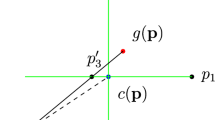Abstract
Generalized location problems withn agents are considered, who each report a point inm-dimensional Euclidean space. A solution assigns a compromise point to thesen points, and the individual utilities for this compromise point are equal to the negatives of the distances to the individual positions. These distances are measured by a given strictly convex norm, common to all agents. Form=2, it is shown that if a Pareto optimal, strategy-proof and anonymous solution exists, thenn must be odd, and the solution is obtained by taking the median coordinatewise, where the coordinates refer to a basis that is orthogonal with respect to the given norm. Furthermore, in that case (m=2) such a solution always exists. Form > 2, existence of a solution depends on the norm.
Similar content being viewed by others
References
Arrow KJ (1963)Social Choice and Individual Values. Wiley, New York
Barbera S, Peleg B (1990) Strategy-Proof Voting Schemes with Continuous Preferences.Social Choice and Welfare 7:31–38
Birkhoff G (1935) Orthogonality in linear metric spaces.Duke Math. J. 1:169–172
Border KC, Jordan JS (1983) Straightforward Elections, Unanimity and Phantom Voters.Review of Economic Studies 50:153–170
Bordes G, Laffond G, le Breton M (1990) Strategy-Proofness Issues in Some Economic and Political Domains. Working Paper, GREQE, Marseille
Chichilnisky G, Heal G (1981) Incentive Compatibility and Local Simplicity. University of Essex and Columbia University
Gibbard A (1973) Manipulation of Voting Schemes: A General Result.Econometrica 41:587–601
Kim KH, Roush FW (1984) Nonmanipulability in Two Dimensions.Mathematical Social Sciences 8:29–43
Kreyszig E (1978)Introductory Functional Analysis With Applications. Wiley, New York
Laffond G (1980) Révelation des Préférences et Utilités Unimodales. Thesis, Paris.
Moreno D, Walker M (1990) Nonmanipulable Voting Schemes when Participants' Interests are Partially Decomposable. Report, Department of Economics, University of Arizona, Tucson, Arizona
Moulin H (1980) On Strategy-Proofness and Single Peakedness.Public Choice 35:437–455
Ostmann A (1982) Fair Solutions for Locational Conflicts.Zeitschrift für Operations Research 26:87–103
Ostmann A, Straub M (1979) On the Geometry behind the Fairness Concept of Rawls and Kolm. University of Bielefeld
Peters H, van der Stel H (1990) A Class of Solutions for Multiperson Multicriteria Decision Problems.Operations Research Spektrum 12:147–153
Peters H, van der Stel H, Storcken T (1991) On Uncompromisingness and Strategy-Proofness. Report M91-15, Maastricht, The Netherlands
Peters H, van der Stel H, Storcken T (1992) Pareto Optimality, Anonymity, and Strategy-Proofness in Location Problems. Forthcoming inInternational Journal of Game Theory
Peters H, van der Stel H, Storcken T (1993) Pareto Optimality and Norms. Report, Maastricht, The Netherlands (forthcoming)
Richter WF (1979) Shapley's Value and Fair Solutions of Location Conflicts. In:Game Theory and Related Topics (ed. by Moeschlin/Pallaschke), North-Holland, Amsterdam
Rosenmüller J (1980) Values of non-sidepayment Games and their Application in the Theory of Public Goods. In:Essays in Game Theory and Mathematical Economics, Bibliographisches Institut/Wissenschaftsverlag, Mannheim
Rosenmüller J (1982) On Values, Location Conflicts, and Public Goods. In:Games, Economic Dynamics, Time Series Analysis, Physica Verlag, Wien-Würzburg
Rubinstein A, Fishburn PC (1986) Algebraic Aggregation Theory.Journal of Economic Theory 38:63–77
Satterthwaite M (1975) Strategy-Proofness and Arrow's Conditions: Existence and Correspondence Theorem for Voting Procedures and Social Choice Functions.Journal of Economic Theory 10:187–217
Satterthwaite M, Sonnenschein H (1981) Strategy-Proof Allocation Mechanisms at Differentiable Points.Review of Economic Studies 48:587–597
Sprumont Y (1989) The Division Problem with Single-Peaked Preferences: A Characterization of the Uniform Allocation Rule.Econometrica, 59:509–519
Zhou L (1990a) Impossibility of Strategy-Proof Mechanisms in Economies with Pure Public Goods.Review of Economic Studies 58:107–119
Zhou L (1990b) Inefficiency of Strategy-Proof Allocation Mechanisms in Pure Exchange Economics. Cowles Foundation, Yale University, New Haven Connecticut
Author information
Authors and Affiliations
Additional information
Supported by a grant from the Cooperation Centre Tilburg and Eindhoven University.
Rights and permissions
About this article
Cite this article
Peters, H., van der Stel, H. & Storcken, T. Generalized median solutions, strategy-proofness and strictly convex norms. ZOR Zeitschrift für Operations Research Methods and Models of Operations Research 38, 19–53 (1993). https://doi.org/10.1007/BF01416005
Received:
Revised:
Issue Date:
DOI: https://doi.org/10.1007/BF01416005




